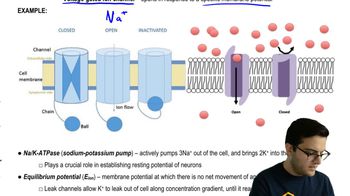Table of contents
- 1. Introduction to Biology2h 42m
- 2. Chemistry3h 40m
- 3. Water1h 26m
- 4. Biomolecules2h 23m
- 5. Cell Components2h 26m
- 6. The Membrane2h 31m
- 7. Energy and Metabolism2h 0m
- 8. Respiration2h 40m
- 9. Photosynthesis2h 49m
- 10. Cell Signaling59m
- 11. Cell Division2h 47m
- 12. Meiosis2h 0m
- 13. Mendelian Genetics4h 44m
- Introduction to Mendel's Experiments7m
- Genotype vs. Phenotype17m
- Punnett Squares13m
- Mendel's Experiments26m
- Mendel's Laws18m
- Monohybrid Crosses19m
- Test Crosses14m
- Dihybrid Crosses20m
- Punnett Square Probability26m
- Incomplete Dominance vs. Codominance20m
- Epistasis7m
- Non-Mendelian Genetics12m
- Pedigrees6m
- Autosomal Inheritance21m
- Sex-Linked Inheritance43m
- X-Inactivation9m
- 14. DNA Synthesis2h 27m
- 15. Gene Expression3h 20m
- 16. Regulation of Expression3h 31m
- Introduction to Regulation of Gene Expression13m
- Prokaryotic Gene Regulation via Operons27m
- The Lac Operon21m
- Glucose's Impact on Lac Operon25m
- The Trp Operon20m
- Review of the Lac Operon & Trp Operon11m
- Introduction to Eukaryotic Gene Regulation9m
- Eukaryotic Chromatin Modifications16m
- Eukaryotic Transcriptional Control22m
- Eukaryotic Post-Transcriptional Regulation28m
- Eukaryotic Post-Translational Regulation13m
- 17. Viruses37m
- 18. Biotechnology2h 58m
- 19. Genomics17m
- 20. Development1h 5m
- 21. Evolution3h 1m
- 22. Evolution of Populations3h 52m
- 23. Speciation1h 37m
- 24. History of Life on Earth2h 6m
- 25. Phylogeny2h 31m
- 26. Prokaryotes4h 59m
- 27. Protists1h 12m
- 28. Plants1h 22m
- 29. Fungi36m
- 30. Overview of Animals34m
- 31. Invertebrates1h 2m
- 32. Vertebrates50m
- 33. Plant Anatomy1h 3m
- 34. Vascular Plant Transport1h 2m
- 35. Soil37m
- 36. Plant Reproduction47m
- 37. Plant Sensation and Response1h 9m
- 38. Animal Form and Function1h 19m
- 39. Digestive System1h 10m
- 40. Circulatory System1h 57m
- 41. Immune System1h 12m
- 42. Osmoregulation and Excretion50m
- 43. Endocrine System1h 4m
- 44. Animal Reproduction1h 2m
- 45. Nervous System1h 55m
- 46. Sensory Systems46m
- 47. Muscle Systems23m
- 48. Ecology3h 11m
- Introduction to Ecology20m
- Biogeography14m
- Earth's Climate Patterns50m
- Introduction to Terrestrial Biomes10m
- Terrestrial Biomes: Near Equator13m
- Terrestrial Biomes: Temperate Regions10m
- Terrestrial Biomes: Northern Regions15m
- Introduction to Aquatic Biomes27m
- Freshwater Aquatic Biomes14m
- Marine Aquatic Biomes13m
- 49. Animal Behavior28m
- 50. Population Ecology3h 41m
- Introduction to Population Ecology28m
- Population Sampling Methods23m
- Life History12m
- Population Demography17m
- Factors Limiting Population Growth14m
- Introduction to Population Growth Models22m
- Linear Population Growth6m
- Exponential Population Growth29m
- Logistic Population Growth32m
- r/K Selection10m
- The Human Population22m
- 51. Community Ecology2h 46m
- Introduction to Community Ecology2m
- Introduction to Community Interactions9m
- Community Interactions: Competition (-/-)38m
- Community Interactions: Exploitation (+/-)23m
- Community Interactions: Mutualism (+/+) & Commensalism (+/0)9m
- Community Structure35m
- Community Dynamics26m
- Geographic Impact on Communities21m
- 52. Ecosystems2h 36m
- 53. Conservation Biology24m
34. Vascular Plant Transport
Water Potential
Problem 3`
Textbook Question
Movement of phloem sap from a source to a sink
a. Occurs through the apoplast of sieve-tube elements
b. Depends ultimately on the activity of proton pumps
c. Depends on tension, or negative pressure potential
d. Results mainly from diffusion
 Verified step by step guidance
Verified step by step guidance1
Understand the concept of phloem sap movement: Phloem sap is transported from a source (where it is produced, like leaves) to a sink (where it is used or stored, like roots or fruits). This process is known as translocation.
Identify the mechanism of phloem transport: Phloem transport is primarily driven by pressure flow, also known as the mass flow hypothesis. This involves the active transport of sugars into the phloem, creating a high osmotic pressure that drives the flow of sap.
Consider the role of proton pumps: Proton pumps are involved in creating a proton gradient across the cell membrane, which is crucial for the active transport of sucrose into the phloem. This active transport is essential for generating the pressure gradient needed for sap movement.
Evaluate the options given: Analyze each option to determine which one correctly describes the mechanism of phloem sap movement. Consider the role of proton pumps and pressure potential in the process.
Conclude with the correct understanding: Based on the pressure flow mechanism, the movement of phloem sap depends on the activity of proton pumps to create the necessary pressure gradient for sap flow from source to sink.
 Verified video answer for a similar problem:
Verified video answer for a similar problem:This video solution was recommended by our tutors as helpful for the problem above
Video duration:
1mPlay a video:
Was this helpful?
Key Concepts
Here are the essential concepts you must grasp in order to answer the question correctly.
Phloem Transport
Phloem transport involves the movement of organic nutrients, primarily sugars, from a source (where they are produced, like leaves) to a sink (where they are used or stored, like roots or fruits). This process is essential for distributing energy throughout the plant and is driven by pressure differences between source and sink.
Recommended video:
Guided course

Active Transport
Proton Pumps
Proton pumps are integral membrane proteins that actively transport protons (H+) across cell membranes, creating a proton gradient. This gradient is crucial for various cellular processes, including the active transport of nutrients in plants, as it provides the energy needed for the movement of substances against their concentration gradient.
Recommended video:
Guided course

Ion Channels and Pumps
Pressure Flow Hypothesis
The pressure flow hypothesis explains the mechanism of phloem transport, suggesting that the movement of sap is driven by a pressure gradient created by osmotic pressure. Sugars are actively loaded into the phloem at the source, increasing osmotic pressure and drawing water in, which generates a flow towards the sink where sugars are unloaded.
Recommended video:
Guided course

Pressure Flow Hypothesis
Related Videos
Related Practice















































